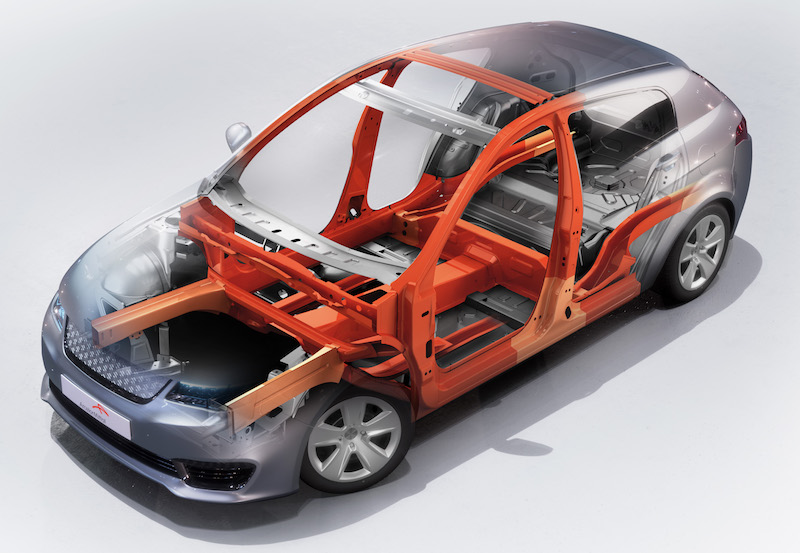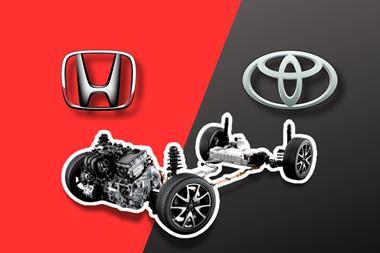
The latest generation of steels brings new opportunities for OEMs
Laser-welded blanks (LWB) give automotive engineers the chance to design lightweight parts that ensure the right steel is in the right place for safety and performance. Combining LWBs with new hot-stamping grades, such as Usibor 2000 and Ductibor 1000, or new cold-stamping steels, such as Fortiform 980 and Fortiform 1180, enables OEMs to achieve additional reductions in vehicle weight at an affordable cost without affecting safety performance.
While laser-welded parts have been around for several years, the evolution of grades suitable for LWBs is making them an even more attractive option than ever before. Some of the most recent innovations have included Usibor 2000 and Ductibor 1000 for hot stamping, and Fortiform 1180 and Fortiform 980 for cold stamping.
Press-hardenable steels for hot stamping

For OEMs that utilise hot stamping, ArcelorMittal offers a range of press-hardenable steels (PHS) that includes the Usibor and Ductibor brands. The latest, Usibor 2000 and Ductibor 1000 offer some of the best weight-saving opportunities. Compared to the earlier Usibor 1500 and Ductibor 500 steels, the new PHS grades offer the potential to reduce weight by another 10-15%, while maintaining or improving existing crash performance.
Usibor and Ductibor were developed with LWBs in mind. Ductibor enhances the energy absorption of an LWB part while Usibor enhances its strength. The new Ductibor 1000 absorbs an additional 15-20% of energy compared to Ductibor 500, while Usibor 2000 achieves an additional 10% weight reduction compared to Usibor 1500. The new grades have been designed to use the same welding processes OEMs use today, ensuring that there are no additional processing costs.
For LWBs, PHS grades offer two significant advantages: increased strength and improved formability. The additional strength in the new grades enhances lightweighting opportunities while improved formability through elongation allows engineers to design more complex parts than ever before. The thickness of parts can be significantly downgauged while still maintaining safety and performance.
Over the past 15 years, demand for PHS grades has grown exponentially. ArcelorMittal has significantly increased the number of production lines for these steels to meet demand and they are now produced in Europe, North and South America, and in Asia.
Third-generation steels for cold stamping
ArcelorMittal’s third generation of steels for cold-stamped LWBs include high formability (HF) grades, such as Fortiform 1180 and Fortiform 980. These steels offer weight savings of up to 10% compared to existing dual phase (DP) grades. The enhanced formability of these grades ensures that OEMs who choose cold stamping for a specific part can also achieve considerable weight reductions.
The Fortiform range offers OEMs an excellent compromise between high strength and formability. The quenching and partitioning process used after cold stamping results in high yield strength and a good hole expansion rate. ArcelorMittal is also developing a range of high-strength, high-formability (HSHF) grades, which will be known as Fortiform S. Now in the final stages of industrialisation, the Fortiform S range will offer weight savings of up to 20% compared to DP grades thanks to their higher strength.
S-in motion practical application of LWBs
Since 2010, ArcelorMittal has developed a number of S-in motion studies which show the lightweighting potential of its latest and emerging grades. LWBs are regularly evaluated as part of these studies.
For example, the S-in motion study on mid-size sedan (see main image) and SUV vehicles identified 23 LWB solutions using both first- and second-generation PHS. Using the lightest options, 78kg of weight savings were identified. Multiple solutions are developed for each part, giving OEMs material and design options which suit their vehicles and processes. Customers can then evaluate which is the best solution for the vehicle under development.
Door ring solution
One of the most interesting LWB applications has been for a one-piece door ring. This single door ring part allows energy management in a range of scenarios while leading to lightweighting and improving the stiffness of the vehicle body. Weight savings of up to 25% are possible using hot-stamped LWB technology.
The single door ring combines a number of side parts which were traditionally spot welded together. Manufacturing the door ring from one LWB creates a continuous load path for energy management in the structure. The laser-welded seam allows the seamless transfer of energy from one part to the other during a crash event and helps to enhance body rigidity. A range of load cases, including front-, side-, and pole-impact scenarios, can be managed much more efficiently using the single-piece LWB. These are some of the most challenging load cases to manage in vehicle design.
There are also many cost efficiencies with this approach. For example, only one stamping tool is required, and there is only one stamping operation to make the entire side structure. Post-assembly operations such as spot welding are eliminated and there is virtually no springback. Another major advantage is the improved geometric accuracy of the part, a key consideration in vehicle assembly.
Co-engineering next-level LWBs
The single LWB door ring is already appearing in production vehicles. In 2014, Honda unveiled the industry’s first hot-stamped, laser-welded door ring for the Honda Acura MDX. This innovation, developed together with ArcelorMittal, significantly lowered the weight of the door ring while bringing improvements to the vehicle’s safety performance.
A laser-welded blank is formed by laser-welding two or more steel sheets of different alloys and/or thicknesses together. Once combined, the part can be hot- or cold-stamped to form the final shape. By combining different steels, or using different thicknesses, engineers can finely tune the performance of the part to meet different load case criteria.
In 2016, ArcelorMittal and Chrysler took LWB technology to the next level by refining the side structure of the 2017 Chrysler Pacifica. The new structure is the result of 36 months of R&D, 2,000 engineering hours, and approximately 300 design iterations. The result is the world’s first five-piece, hot-stamped, laser-welded door ring combined with a hot-stamped B-pillar. The new part brings significant advantages for Chrysler, including weight reductions of 8.64kg, reduced material costs and a simplified manufacturing process. The Pacifica became the first vehicle in the minivan class to achieve an IIHS 2017 Top Safety Pick Plus award.
Steel matters
The commercialisation of ArcelorMittal’s latest Usibor and Ductibor PHS grades for hot stamping, and Fortiform grades for cold stamping, gives OEMs new opportunities for lightweighting using LWBs. With their low cost compared to alternative materials and excellent safety performance, LWBs help ensure that steel will remain the material of choice for carmakers for the long-term.
Watch a webinar about lightweighting with laser welded blanks, presented by ArcelorMittal’s specialists at: automotivemanufacturingsolutions.com/webinars-podcasts






































